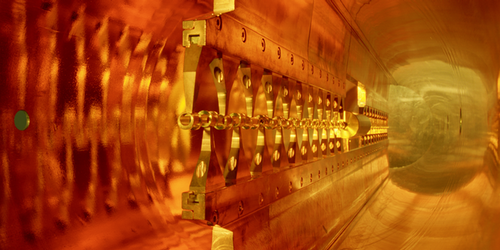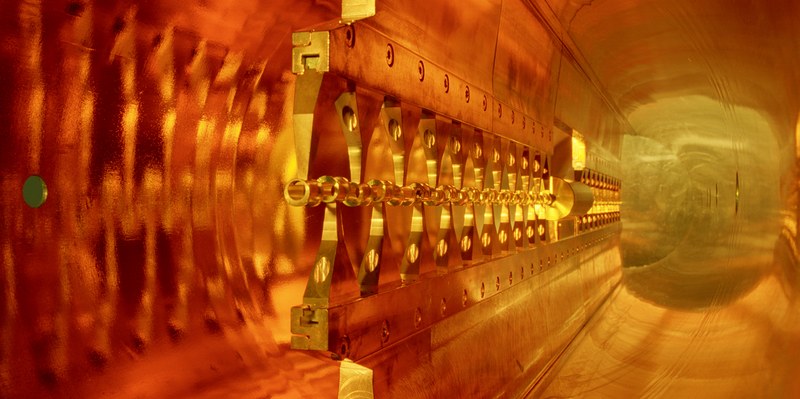Laser Bags a Giant Nucleus
The precise structure and shape of an atomic nucleus is a key indicator of the balance of forces that govern it. Measuring these properties for the heaviest nuclei is especially difficult, but an international collaboration has now obtained this information for some of the heaviest nuclei known. The team applied a recently developed laser technique to isotopes of nobelium, element 102, and measured the degree to which the nuclei were nonspherical, as well as the reduced density in the center of two of the isotopes. The findings may improve estimates for the properties of the “island of stability”—a putative regime of superheavy, extra-stable nuclei that may exist for still heavier elements.
Nuclear physicists would like to understand and ultimately predict the properties of nuclear matter, and superheavy nuclei (those heavier than uranium, element 92) are the most difficult to model. Besides their relative instability—they are prone to fast radioactive decay—the superheavies differ from the generally stable nuclei of lighter atoms in other ways. For example, the large repulsion between protons, combined with the high angular momentum, can lead to highly nonspherical shapes. And the strong proton-proton repulsion can also lead to a region of lower density in the center.
Such properties push the theory of nuclear structure to its limits. And it’s hard to check predictions of the shape and structure of these nuclei because superheavy elements must be created atom-by-atom from high-energy collisions and because their radioactive half-lives are often just a few seconds or less. So little is known about the shapes of nuclei heavier than fermium, element 100. There have been some indirect signs that elements such as nobelium and rutherfordium (element 104) are nonspherical (as theory predicts), but these hints have been inconclusive.
A team led by Sebastian Raeder at the GSI Helmholtz Center for Heavy Ion Research in Darmstadt, Germany, set their sights on nobelium. They employed a recently developed technique that allows researchers to probe nuclear structure with high precision using laser spectroscopy of single atoms. Electronic transitions identifiable in an atom’s absorption spectrum (measured here with an ultraviolet laser) are affected by interactions between the electron spins and the nuclear spin, so the spectrum contains information about the nucleus. The technique provides a high detection efficiency that is unavailable with any other method but that is essential when researchers have only a few atoms to work with.
The team fired calcium ions at a target of lead, producing nobelium isotopes with atomic masses of 252, 253, and 254. These isotopes have half-lives of 2.4, 97, and 51 seconds. The researchers compared their spectroscopic measurements with theoretical calculations to extract nuclear information. They used three different models for the calculations—all of which agreed—to help rule out any dependence of the findings on the assumptions of a particular theory.
Raeder and his colleagues report that all of the nobelium nuclei have a shape resembling an American football. Nobelium-252 and -254 are predicted to have a central density of protons about 12% lower than that at the surface, and the measurements agree with this expectation. “Although our measurements only provide an indirect indication of this central density depression, no other experimental techniques are currently available to assess this property,” says Raeder.
“The experiment was a big challenge, and this is a fantastic breakthrough in the field,” says nuclear physicist Christophe Theisen of the French Alternative Energies and Atomic Energy Commission (CEA) in Gif-sur-Yvette. He says that these are the heaviest nuclei whose structures have been studied with the high precision available with laser spectroscopy.
Theisen says that the observations of nobelium-253 are particularly impressive because its odd number of neutrons gives the nucleus magnetic properties that cause a splitting of the electronic energy levels. So the laser-produced spectrum provided a direct measurement of certain nuclear properties, such as the magnetic dipole moment, with no need for comparisons with calculations, as was required for the other parameters. The work overall is “one of the most beautiful of the decade,” says Theisen.
Theisen now expects researchers to study still heavier nuclei, approaching the predicted island of stability. This island is a major focus of nuclear theory, and its expected location in the nuclear chart depends on calculations that may need to account for a central depression in the nuclear density, says nuclear physicist Paul Greenlees of the University of Jyväskylä in Finland.
This research is published in Physical Review Letters.
–Philip Ball
Philip Ball is a freelance science writer in London. His latest book is How Life Works (Picador, 2024).
More Information
P. Chhetri et al., "Precision Measurement of the First Ionization Potential of Nobelium," Phys. Rev. Lett. 120, 263003 (2018).





